
In Dr. Tim Lucas, Ohio State University didn't so much recruit an NIH-funded neurosurgeon away from Penn – it acquired a business plan.
Lucas was hired in August 2021 to become the first CEO of the NeuroTech Institute – an independent nonprofit that OSU and research giant Battelle publicly launched on Wednesday. Its mission: speed up the chronically slow process of turning academic discoveries into therapies and medical devices helping patients.
Seeded with an estimated $28 million for operations and researchers, NeuroTech aims to raise $120 million in federal grants and philanthropy in the next few years toward spinning out Columbus biotech startups and landing licensing deals with big pharma.
"You get a lot of provisional patents that get filed, but then that art never gets developed into a company that becomes a business," Lucas said in an interview. "The best discovery in the world in a laboratory means nothing right now to a patient in my clinics.
"All major universities have this problem of tech transfer."
Indeed, OSU has been working to increase the rate of royalty-generating licenses and spinoff creation for more than 15 years.
This three-legged structure changes things, Lucas said: engineering expertise and operations infrastructure from Battelle, Ohio State’s deep and broad bench of academic research, and a separately incorporated institute that can act quickly on research collaborations without all the red tape.
Lucas modeled the structure after Broad Institute of MIT and Harvard, founded in 2004 to commercialize technology from sequencing the human genome. A fixture in Cambridge's Kendall Square biotech hub, it played a role in developing CRISPR gene editing and has spun out companies worth billions today. A Broad spinout filed for a $100 million IPO last week, the Boston Business Journal reported.
Research institutions around the country have tried to commercialize neurotechnology, but moving outside the lab into business isn't their forte, said Justin Sanchez, life sciences research fellow at the $10 billion Battelle and one of its representatives on the NeuroTech board.
"It’s a startup here, a startup there. They never have a Battelle also in the mix," Sanchez said. "(At the same time,) Battelle can't do it alone. We do need the foundational research out of OSU."
One of the first technologies in the pipeline is a long-running collaboration between Battelle inventors and OSU clinicians: NeuroLife neural bridge, a sleeve with embedded electrodes that receive signals from the brain to allow a patient to move a paralyzed arm and hand. As I've reported, the technology has advanced from the huge skull plug implanted in the first experimental patient, Ian Burkhart. Now vice president of North American Spinal Cord Injury Consortium, Burkhart is still involved in the research and is an advisor to the new institute.
The team is working to make the connection two-way, Lucas said: Restore the brain's sensation of where the hand is positioned in space and how tightly it's gripping. Other NeuroLife technologies in development don't require a brain implant.
Overall the institute will develop technologies in three main themes, Lucas said:
- Cyberphysical: Technologies like NeuroLife that restore communication between brain and body, whether because of a severed connection or a "noisy" connection like the over-firing neurons that cause some forms of chronic pain.
- Cellular modulation: Gene therapies and other approaches in disorders where a single gene disrupts an essential protein, as in muscular dystrophy.
- Neural networking: Identifying abnormal neural nodes in the brain network behind conditions including autism, schizophrenia, addiction and obsessive compulsive disorder, and develop treatments to "turn those nodes on or off."
How the institute is structured
Eight years ago, Ohio State formed a for-profit LLC, Neurotechnology Innovation Translator, that looked around the country for medical devices and therapies that it could nurture into companies, as opposed to only spinning tech out of the university. Its $160 million in pledged funding and in-kind services included a $21 million Third Frontier grant. Its Battelle representative left after a year, and its lead OSU researcher left in 2017. The LLC was dissolved in 2019, records show, after creating two companies that are now in clinical trials.
Structuring the new institute as an independent nonprofit was essential to create the flexibility to stay ahead of rapid changes in technology, markets and regulation, Sanchez said. The partners spent the past several months hammering out policies and procedures on how to handle intellectual property, nondisclosure agreements and minutiae.
"We want personnel from all three entities to freely exchange ideas and work together, … unencumbered by old ways," Sanchez said. "We did the hard work of establishing the rules of engagement up front, so people don’t have to worry about them later."
Lucas was on faculty for nearly 11 years at University of Pennsylvania's Penn Medicine. He brought the business plan for a technology accelerator to Penn leadership, but was told the university lacked resources, he said. He was in talks with Harvard and the Cleveland Clinic when OSU and Battelle – already wanting to form such an entity – got wind and came to him with a better offer.
A neurosurgeon and engineer who specializes in epilepsy, Lucas brought four NIH grants to OSU that total $1.8 million for this fiscal year, according to the agency. He spends on average one day a week treating patients and the rest of his time on the institute, which he incorporated in February.
OSU and Battelle each have pledged $5 million for operations. The rest of the funding is the estimated cost for the university to recruit 20 faculty and equip their labs; they will be "leased" to the institute as it works to commercialize technology, Lucas said. For now the institute does not have a designated office location, an OSU spokesman said.
"We are open to engagement with others who can pile on to the investment," Sanchez said.
In as soon as a year, Sanchez said, the institute expects to be running "clinical trials that make people go 'wow.'"







